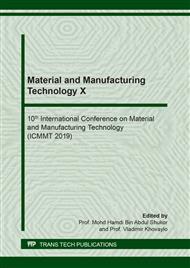[1]
W. A. Harrison: Phys. Rev. Vol. 123 (1961), pp.85-89.
Google Scholar
[2]
F. A. Noor, M. Abdullah, Sukirno and Khairurrijal: J. Semicond. Vol. 31 (2010), pp.124002-1/5.
Google Scholar
[3]
B. C. Pursley, X. Song, R. O. Torres-Isea, E. A. Bokari, A. Kayani and V. Sih: Appl. Phys. Lett. Vol. 106 (2015) 072403.
DOI: 10.1063/1.4907286
Google Scholar
[4]
D. D. Awschalom, M. E. Flatte and N. Samarth: Sci. Am. Vol. 286 (2002), pp.66-73.
Google Scholar
[5]
H. Akinaga and H. Ohno: IEEE Trans. Nanotechnology Vol. 1 (2002), pp.19-31.
Google Scholar
[6]
B. T. Jonker: Proceedings of the IEEE Vol. 91 (2003), pp.727-740.
Google Scholar
[7]
V. I. Perel, S. A. Tarasenko and I. N. Yassievich: Phys. Rev. B Vol. 67 (2003), pp.201304-1/4.
Google Scholar
[8]
G. Schmidt, D. Ferrand, L. W. Molenkamp, A. T. Filip and J. Wees: Phys. Rev. B Vol. 62 (2000), pp. R4790-R4794.
Google Scholar
[9]
K. C. Hall,W. H. Lau, K. Gundogdu and M. E. Flatte: Appl. Phys. Lett. Vol. 83 (2003), pp.2937-2939.
Google Scholar
[10]
A. Voskoboynikov, S. S. Liu and C. P. Lee: Phys. Rev. B Vol. 58 (1998), pp.15397-15401.
Google Scholar
[11]
A. Boda, B. Boyacioglu, U. Erkaslan and A. Chatterjee: Physica B Condens Matter Vol. 498 (2016), pp.43-48.
Google Scholar
[12]
H. Dakhlaoui and S. Jaziri: Physica B Vol. 355 (2005), pp.401-407.
Google Scholar
[13]
N. Lebedeva and P. Kuivalainen: J. Appl. Phys. 93, 9845-9864 (2003).
Google Scholar
[14]
K. Michaeli, V. Varade, R. Naaman and D. H. Waldeck, J. Phys: Condens Matter Vol. 29 (2017), pp.103002-1/8.
DOI: 10.1088/1361-648x/aa54a4
Google Scholar
[15]
A. B. Suryamas, M. Abdullah and Khairurrijal: Indonesian J. Phys. Vol. 17 (2006), pp.43-46.
Google Scholar
[16]
A. B. Suryamas, M. Abdullah and Khairurrijal: Transmittance Coefficient of Electron Tunneling through a Nanometer Thick Square Barrier with Spin Polarization Consideration, International Conference on Mathematics and Natural Sciences (ICMNS) (Bandung, 29-30 November 2006) p.941.
Google Scholar
[17]
D. J. BenDaniel and C. B. Duke: Phys. Rev. Vol. 152 (1966), pp.683-691.
Google Scholar
[18]
F. A. Noor, M. Abdullah, Sukirno, Khairurrijal, A. Ohta and S. Miyazaki: J. Appl. Phys. Vol. 108 (2010) pp.093711-1/5.
Google Scholar
[19]
De Vries P L: A first Course in Computational Physics, John Wiley & Sons, New York (1993).
Google Scholar


